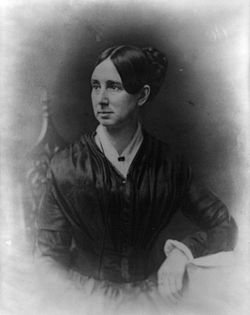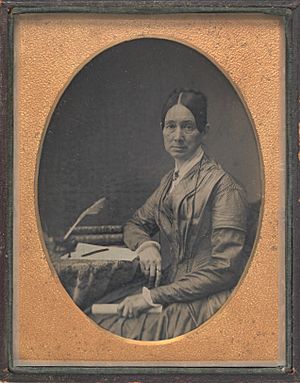Dorothea Dix facts for kids
Quick facts for kids
Dorothea Dix
|
|
|---|---|
 |
|
| Born |
Dorothea Lynde Dix
April 4, 1802 Hampden, Maine, US
|
| Died | July 17, 1887 (aged 85) |
| Occupation | Social reformer |
| Parent(s) | Joseph Dix Mary Bigelow |
| Signature | |
 |
|
Dorothea Lynde Dix (April 4, 1802 – July 17, 1887) was an American champion for people with mental health challenges who were poor. She worked hard to convince state governments and the United States Congress to create the first special hospitals for people with mental illnesses in America. During the American Civil War, she was in charge of all the Army Nurses.
Contents
Early Life and Education
Dorothea Dix was born in Hampden, Maine. She grew up in Worcester, Massachusetts, near her parents' family. She was the oldest of three children. Her mother was often sick, and her father traveled a lot as a bookseller and preacher.
When Dorothea was twelve, she and her two brothers went to live with their rich grandmother in Boston. At fourteen, Dorothea started teaching at a girls' school in Worcester. She even created her own lessons, focusing on good behavior and science.
Around 1821, Dix opened a school in Boston for wealthy families. She also taught poor children in her grandmother's barn. However, she often had poor health. Some people think she suffered from depression, which made her health worse.
Writing for Young Readers
From 1824 to 1830, Dix wrote books, mostly religious ones and stories for children. Her book Conversations on Common Things (1824) was very popular. It was written like a chat between a mother and daughter and was reprinted 60 times. She also wrote The Garland of Flora (1829), which was one of the first books in the U.S. to explain the "language of flowers."
A New Path: Helping Others
Because of her poor health, Dix had to stop teaching. She then worked as a governess for the family of William Ellery Channing, a famous Unitarian thinker. While with them, she visited St. Croix and saw slavery firsthand.
In 1831, she opened another school for girls in Boston, which she ran until 1836. After getting sick again, she traveled to England to get better. There, she met British social reformers like Elizabeth Fry and Samuel Tuke. They believed that governments should actively help people in need. She learned about their work to improve care for people with mental illnesses in Great Britain.
While in England, her grandmother passed away and left her a lot of money. This meant Dorothea could live comfortably for the rest of her life.
Working for Mental Health Reform
When Dix returned to America, she started investigating how poor people with mental illnesses were treated in Massachusetts. Her interest began when she was teaching classes to women in a prison. She saw how people with mental health issues were kept in terrible conditions, often locked up with criminals, and treated very badly. Their cells were dark, dirty, and had bad air.
Speaking Out for Change
In 1843, Dix published a powerful report called a Memorial to the Massachusetts government. She described the terrible conditions she saw. Her efforts led to a law that expanded the state's mental hospital in Worcester.
Dix then traveled to New Jersey in 1844, visiting jails and poorhouses. She wrote another detailed report for the New Jersey government. She urged them to spend money to build a proper facility for people with mental illnesses. She shared stories, like that of an old man who was once a respected leader but was now living in a cold, bare basement. Many lawmakers knew this man, and her story helped convince them.
On March 25, 1845, a law was passed to build a state mental health facility in New Jersey.
Across the Country
Dorothea Dix traveled all over the U.S., from New Hampshire to Louisiana. She documented the poor conditions for people with mental illnesses and reported her findings to state governments. She worked with lawmakers to create new laws and get money for better care.
- In 1846, she went to Illinois and helped establish its first state mental hospital.
- In 1848, she visited North Carolina. After some effort, a bill for reform was approved. In 1849, a hospital was authorized in Raleigh. It opened in 1856 and was later renamed the Dorothea Dix Hospital in her honor.
- She also helped found the first public mental hospital in Pennsylvania, the Harrisburg State Hospital. In 1853, she even set up its library.
A National Effort and International Work
Dix tried to pass a national law called the "Bill for the Benefit of the Indigent Insane." This bill would have set aside millions of acres of federal land. The money from selling this land would go to states to build and maintain hospitals for people with mental illnesses, as well as for the blind and deaf. The bill passed Congress, but President Franklin Pierce vetoed it in 1854. He believed that social welfare was the states' responsibility, not the federal government's.
After this setback, Dix traveled to England and Europe. She continued her investigations, looking into mental hospitals in Scotland. Her work led to the creation of the Scottish Lunacy Commission, which helped bring about reforms.
She also visited the British colony of Nova Scotia in 1853. While there, she helped rescue people from a shipwreck on Sable Island. When she returned to Boston, she successfully campaigned to send better life-saving equipment to the island.
In 1854, Dix found similar poor conditions in mental hospitals in Scotland. After years of work, reform laws were passed in 1857. She also worked for 13 years to get an asylum built in the Channel Islands.
Dix even traveled to Rome. She found terrible conditions there and met with Pope Pius IX. The Pope was shocked by what she told him and visited the hospitals himself. He thanked Dix, saying that "a woman and a Protestant, had crossed the seas to call his attention to these cruelly ill-treated members of his flock."
The Civil War: Superintendent of Army Nurses
During the American Civil War, Dorothea Dix was appointed Superintendent of Army Nurses for the Union Army on June 10, 1861.
She set strict rules for nurses:
- They had to be between 35 and 50 years old.
- They had to be plain-looking and wear simple black or brown dresses, with no jewelry or makeup. Dix wanted to protect young women from harm in the hospitals.
Dix often disagreed with Army doctors about how hospitals should be run and who should be hired. Many doctors did not want female nurses in their hospitals. In 1863, the War Department created a new rule that allowed both the Surgeon General and Dix to appoint female nurses. However, doctors still decided where nurses would work.
As superintendent, Dix helped create the federal army nursing program. Over 3,000 women served as nurses during the war. Dix resigned in August 1865. She later felt this part of her career was a failure, partly because she struggled to work with Catholic nurses.
Despite the challenges, Dix was respected for caring for both Union and Confederate wounded soldiers. Her nurses often provided the only care available to Confederate soldiers left behind after battles. For example, after the Battle of Gettysburg, Dix's nurses treated 5,000 wounded soldiers left behind by the Confederates.
Her dedication during the war was recognized. She was awarded two national flags for her work in "the Care, Succor, and Relief of the Sick and wounded Soldiers of the United States on the Battle-Field, in Camps and Hospitals during the recent war." Dix helped establish 32 hospitals and influenced the creation of two more in Japan.
Later Life and Legacy
After the war, Dix continued her work to improve conditions for prisoners and people with disabilities or mental illnesses. She first toured hospitals and prisons in the Southern U.S. to see the damage from the war. She also worked on improving life-saving services in Nova Scotia and helped create a war memorial in Virginia.
In 1881, Dix moved into the New Jersey State Hospital, which she had helped build years before. The state government set aside a special suite for her to live in for the rest of her life. Even though she was in poor health, she kept in touch with people from all over the world. Dorothea Dix passed away on July 17, 1887, and was buried in Mount Auburn Cemetery in Cambridge, Massachusetts.
Honors and Recognition
- Dix was named "President for Life" of the Army Nurses Association.
- In December 1866, she received two national flags for her service during the Civil War.
- In 1979, she was added to the National Women's Hall of Fame.
- In 1983, the United States Postal Service honored her with a special postage stamp.
- In 1999, a series of marble panels with bronze busts were added to the Massachusetts State House, including one of Dix.
- A United States Navy transport ship during World War II was named the USS Dorothea L. Dix.
- The Bangor Mental Health Institute in Maine was renamed the Dorothea Dix Psychiatric Center in 2006.
- A crater on Venus was named Dix in her honor.
- She is remembered on the Boston Women's Heritage Trail.
Many places are named after Dorothea Dix, including the Dix Ward in McLean Asylum, Dixmont Hospital in Pennsylvania, and the Dorothea Dix Park in Raleigh, North Carolina.
Works for Young Readers
- Conversations on common things (1824)
- Alice and Ruth
- Evening Hours
See also
 In Spanish: Dorothea Dix para niños
In Spanish: Dorothea Dix para niños
- Other nurses of the American Civil War:




